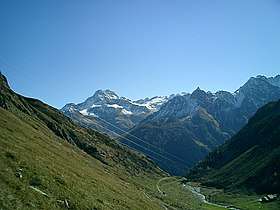Septimer Pass
Septimer Pass (German: Septimerpass, Italian: Passo del Settimo, Romansh: Pass da Sett; elevation 2,310 meters or 7,580 feet) is a high mountain pass in the canton of Graubünden in the Swiss Alps between the valleys of Bregaglia (Bergell) and Oberhalbstein (Surses). During the Middle Ages, this, the Great St. Bernard, and the Brenner Passes were the preferred routes over the Alps for traveling emperors.[1]
| Septimer Pass | |
|---|---|
 Septimer Pass | |
| Elevation | 2,310 m (7,579 ft) |
| Traversed by | Trail |
| Location | Switzerland |
| Range | Alps |
| Coordinates | 46°25.2′N 09°38.28′E |
 Septimer Pass Location of Septimer Pass | |
Already in use by the Romans, who maintained a legion camp in the pass around AD 15–16,[2] this pass was an important trade route from Milan through Bivio to Augsburg[3] It was easier to use than the Splügen Pass, due to the latter having the difficult gorges of the Hinterrhein River.[4] One of the earliest mentions of a Christian hospice was the one placed at the pass itself, mentioned in 831. It was mentioned in documents for the following millennium, even though it was abandoned in the tenth century and rebuilt at the beginning of the eleventh. (The hospice was later abandoned for good in 1778.)[5] During the Middle Ages the Septimer Pass was crucial to the temporal power of the Bishopric of Chur,[6] whose extensive territories until the fourteenth century included Chiavenna. In 1236 the St. Gotthard Pass opened, allowing traffic from Lucerne to Milan, which diverted merchants from going through Chur.[7] The pass further lost importance after the construction of roads over the Julier[8] and Maloja passes.[9]
Notes
- Hyde, 325. Freshfield, 20.
- Fassbinder, 69.
- Freshfield, 18.
- Freshfield, 19.
- Hyde, 325-6.
- Freshfield, 20.
- Freshfield, 18.
- Freshfield, 20.
- Munro, 31, note 81.
Sources
- Fassbinder, Jörg, et al. "Magnetic prospecting of the Roman military camp at Septimer Pass (Switzerland)." Open Journal of Archaeometry 2014, volume 2:5303, 69–71. Accessed on May 11, 2015 from https://www.academia.edu/6159778/Magnetic_prospecting_of_the_Roman_military_camp_at_Septimer_Pass_Switzerland_
- Freshfield. Douglas W. "The Great Passes of the Western and Central Alps." The Geographical Journal, Vol. 49, No. 1 (Jan., 1917), pp. 2–22. Stable URL: https://www.jstor.org/stable/1779776
- Hyde, Walter W. "The Alpine Passes in Nature and History." The Scientific Monthly, Vol. 45, No. 4 (Oct., 1937), pp. 317–330. Stable URL: https://www.jstor.org/stable/16413
- Munro, John H. "The 'New Institutional Economics' and the Changing Fortunes of Fairs in Medieval and Early Modern Europe: the Textile Trades, Warfare, and Transaction Costs." VSWG: Vierteljahrschrift für Sozial- und Wirtschaftsgeschichte 88. Bd., H. 1 (2001), pp. 1–47. Stable URL: https://www.jstor.org/stable/20740358